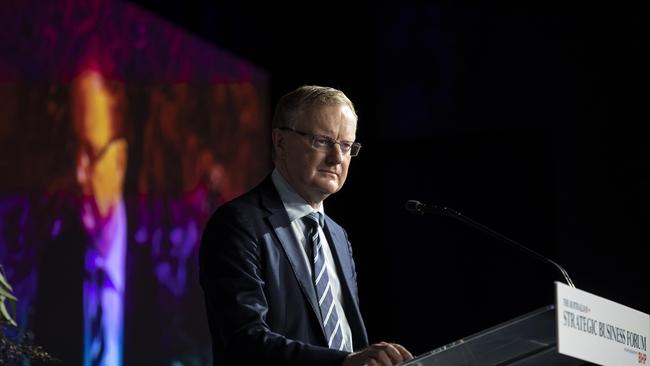Central bankers singing from same song sheet
Markets might be priced in for another large interest rate hike, but attention is turning to see if the RBA governor will use a key speech next week to articulate a surprisingly hawkish view.

Business
Don't miss out on the headlines from Business. Followed categories will be added to My News.
Will Philip Lowe follow Jerome Powell’s Jackson Hole speech with a hawkish message of his own?
The market is largely priced for another large interest rate hike of 50 basis points by the RBA at its meeting next Tuesday, and the RBA governor could well use his Anika Foundation speech on the economic outlook and monetary policy next Thursday week to articulate a surprisingly hawkish view.
While no RBA officials attended the Jackson Hole Economic Policy Symposium in Wyoming this year, Western central banks often sing from a similar song sheet. Moreover, the Anika Foundation address has often been used by the RBA to deliver a powerful message to financial markets and the public.
In last year’s speech on delta, the economy and monetary policy, Dr Lowe explained the need to stay the course on monetary policy stimulus to offset the impact of Covid-19 lockdowns, even though he didn’t expect the pandemic to “derail” the economy.
This year’s speech may focus on the need to stay the course on increasing interest rates until the bank is confident that rates are restrictive enough to lower inflation to its 2-3 per cent target band.
Much of the surge in inflation to multi-decade highs this year has been caused by supply issues.
But with the Australian economy thought to be running about six months behind the US in the post-Covid-19 cycle, domestic inflation is projected to worsen. The RBA’s forecasts earlier this month projected a peak of 7.8 per cent for the CPI in December versus 6.1 per cent in the June quarter, even assuming “market pricing” of a rise in the cash rate to around 3 per cent by the end of 2022.
Like the Fed, the RBA doesn’t have much choice other than to slow the economy.
Dr Lowe may point to sharply weaker consumer confidence and cooling house prices as early signs that higher interest rates are starting to cool the economy.
However, there are scant signs of a much-needed slowdown in the hard data, even if the gap between consumer and business confidence has risen to unusually wide levels. No doubt he will point to the RBA’s business liaison which has found higher inflation outcomes have been a factor in recent wage negotiations. In its statement on monetary policy this month, the RBA said that over 60 per cent of businesses that reported their expectations in the RBA’s business liaison program so far in 2022 expected to raise wages by more than 3 per cent over the year ahead.
Businesses expected the pick-up to be broadly based, rather than limited to specific industries or occupations, and the lift in expected wages growth “reflects firms responding to higher voluntary turnover and stronger inflation”, the RBA said.
It will be hard for Dr Lowe to avoid touching on the lessons of the past, as Mr Powell did when he highlighted the importance of the public expecting inflation to “remain low and stable”.
“During the 1970s, as inflation climbed, the anticipation of high inflation became entrenched in the economic decision-making of households and businesses,” Mr Powell said last Friday. “The more inflation rose, the more people came to expect it to remain high, and they built that belief into wage and pricing decisions.”
Australia had a similar experience with inflation in the 1970s and the need to avoid inflation expectations becoming entrenched here is just as important as it is in the US.
Interestingly global financial markets appeared set to stabilise despite Powell’s surprisingly hawkish message, which came along with similarly tough talk from European Central Bank officials. After plunging 3.4 per cent in response to Mr Powell’s speech on Friday, the S&P 500 fell just 0.7 per cent on Monday and futures were pointing to a 1 per cent rise on Tuesday.
It came as the US 10-year bond yield fell 5 basis points to 3.05 per cent in Tuesday’s Asia-Pacific session after hitting a two-month high of 3.13 per cent after Mr Powell’s speech.
But the market clearly misread Fed rhetoric in recent months as pointing to a “Fed pause”.
While noting that “at some point, as the stance of monetary policy tightens further, it likely will become appropriate to slow the pace of increases”, Mr Powell said the slight fall in US inflation in July “falls far short” of what the Fed needs to be confident that inflation is moving down.
“In current circumstances, with inflation running far above 2 per cent and the labour market extremely tight, estimates of longer-run neutral are not a place to stop or pause,” he said.
Mr Powell also said “another unusually large increase could be appropriate” in September.
And he highlighted the fact that the Fed’s latest “dot-plot” projections have the Fed funds rate “running slightly below 4 per cent through the end of 2023”.
The updated Fed dot-plot next month is likely to see the median estimate of the Fed funds rate for year-end increased to 3.7 per cent from 3.38 per cent, in line with market thinking.
In light of Mr Powell’s speech, it seems a stretch for the median dot for 2023 to fall in line with market estimates around 3.45 per cent versus the June estimate of 3.75 per cent and also to be revised down further for 2024, as the market currently expects.
Expectations will be shaped by US jobs, ISM and CPI data in the coming weeks, as well as overall financial conditions. Barring significant cooling, markets must face up to higher for longer interest rates.
Originally published as Central bankers singing from same song sheet



